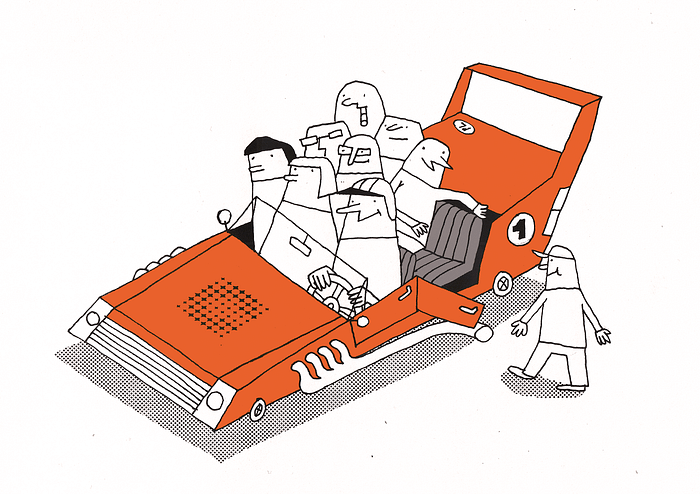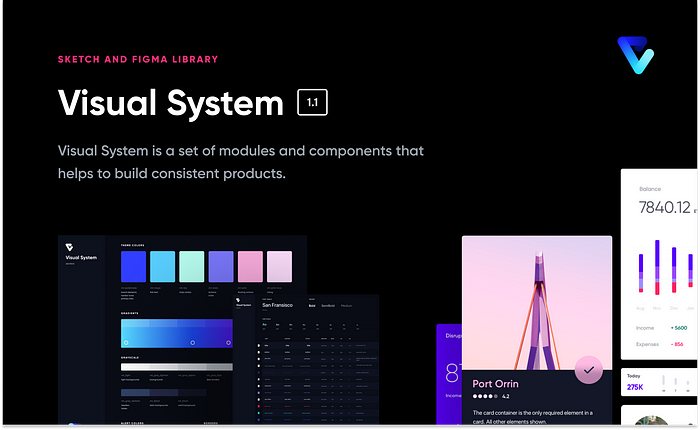How to grow as a Junior UI Designer
Design System for Sketch and Figma — www. visualsystem.co
Learn 5 design fundamentals
The fundamentals of graphic design are about seeing (and understanding) how the design qualities work together. Then being able to decide which qualities of each are relevant and engaging and useful for visualizing a particular idea. Start by learning 5 most important qualities:
I know. That’s a lot. But without being at least good with those skills next step will be imposible to achieve.
Build your portfolio
If you want to get job offers or work inquiries it’s REQUIRED to have stunning up to date portfolio. The form is not so important. It can be Dribbble, Behance or your own website but the goal is the same. You need to show your skills, you need to explore different areas of design and be consistent with it.
Trust your portfolio like design degree. The best part is that you can change it every day.
Build concept works, redesign.. basically whatever you want. It’s not waste of time. It’s not like begging. It’s investment in your skills and building self-brand.
Level Up Hard Skills
As a Junior, you know basics of graphics software and your goal should increase this knowledge. You probably think “hmm but there are so many tools”. Don’t worry you don’t need to learn everything. As a Junior you should learn only:
- Sketch (or Figma/Adobe xD)
- Principle/Flinto
- Illustrator

Sketch Mastery

One of the best things you can do to learn software better is to watch how other, more experienced designers used it. These days you have a tremendous amount of videos available on YouTube. It can be boring at the beginning but pay attention and you will learn a lot of workflow tricks, shortcuts etc.
Get starded with motion
It’s recommended to start your journey with motion early. But for the beginning, you shouldn’t worry about tools like After Effects or Framer. You need to learn the basics. How keyframe animation works, easing, types of motion etc. Start by using tools compatible with Sketch like Principle or Flinto. It’s crucial to learn those basics if you want to have an interesting portfolio.
The best article you can find about motion basics 👇
Illustrator
Since sketch isn’t the best tool when it comes to illustration design you should also have basics of Adobe Illustrator. Don’t worry. You don’t need to know everything at your level, but the ability to produce icons or simple illustrations will be more than helpful for you and your agency.
Theory

I’ve read quite a few UI design books over 8 years and they’ve definitely helped me gain a solid foundation in the principles of UI design. More importantly, having strong theory knowledge helps to explain your design decisions to your client/supervisor. Reading is awesome, but your time has constraints so you need to choose your books wisely. Let’s see what’s the best to start with.
Don’t make me think
If you’ve ever tried searching for something only to get results for something totally different, you know how frustrating it can be. This book helps business owners and marketers think like consumers. It helps you keep the focus on the customer — a fundamental rule when you write.

How to use graphic design
A monograph, manual and manifesto by one of the world’s leading graphic designers. Rough sketches and rejected ideas sit alongside finished work. How to.. is packed with insights into the creative process, making it a valuable resource to new and established designers alike.

Thinking with Type
Ellen Lupton’s excellent analysis of thinking with typography is perfect for everyone from the first-year student to the seasoned professional. The book covers an expansive amount of typographic information including an application, theory, and practice and manages to keep everything lighthearted and fun so that the pages just keep on turning.

The Best Interface Is No Interface
Krishna asserts that designers have a duty to solve problems efficiently through user-centered thinking. This entertaining book is about the problems with today’s design thinking. The overall aim of NoUI is to move beyond screens by designing a more personal, efficient experience.

UX Pin Ebooks

Soft Skills

Ask questions
As a novice, you should listen to other people. Ask for feedback on your designs. Ask colleagues at work about workflow, how to speed up your process. Instead of struggling and learning bad habits on your own just talk to people. There is always something new to learn. You will be surprised how many mistakes are you doing every single day.
Be very critique
About yourself and your work. Falling in love with your decisions and designs is like cancer for designers. You should lever your choices, build a few version, think what is bad about your work and how to improve it. Without it, you will never progress.
What tools or knowledge will help you get to the next phase in your career?
“Being exposed and connected to amazing, inspiring individuals doing things that I would love to explore.”
Surround yourself with proffesionals
In order to grow you need to be learning new skills and new interaction models. That typically means you need a group of people to learn from, and that means you should be looking to join a team with skilled team members in it. The other solution is to find a mentor. Someone who can give you feedback, answer a technical question, give you advice etc. Additionally, you should create a separate Instagram account to follow people that share their workflow, behind the scenes and work in progress designs. Here are my favs:




Replicate other designers
Many juniors believe that their design idols are unicorns or special in some way. We have an innate ability to create stunning visuals, a natural talent for matching complementary colors, an unexplainable intuition for building beautiful typography. None of this is true. Becoming a great designer actually takes years of hard work, experimentation, and failure. It’s a craft man ship. You gain “talent” by spending tons of hours learning and practicing to achieve a particular level.
Conclusion
As you see there is no simple trick to get better. It’s a combination of hard work, smart time investment, and self-discipline. Hopefully, this article will help you achieve a medium level which I will talk about in the next article. Thanks!





